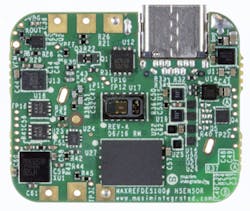Growing interest in wearable health and fitness monitoring devices and clothing is creating a difficult-to-meet demand for manufacturers. Fortunately, the MAXREFDES100# reference design from Maxim Integrated helps shave a good part of the development time by integrating several sensors on a tested and working printed-circuit board (PCB). The reference design is a good fit for health and medical devices equipped with Internet of Things (IoT) capabilities for ease of transferring data.
The modular reference design (see figure) includes a model MAX30003 biopotential analog front-end integrated circuit (IC), a model MAX30101 pulse oximeter and heart-rate sensor, two MAX30205 human-body temperature sensors, a three-axis accelerometer, a three-dimensional (3D) accelerometer and gyroscope, and an absolute barometric pressure sensor. The integrated solution measures just 25 × 30 mm; is optimized for low power consumption; and is supplied with software drivers, a debugging PCB, and a graphical user interface (GUI) to help speed the final-product design process. The design kit even includes standard and micro Universal Serial Bus (USB) cables for connecting the reference design board to a PC for programming.
About the Author
Jack Browne
Technical Contributor
Jack Browne, Technical Contributor, has worked in technical publishing for over 30 years. He managed the content and production of three technical journals while at the American Institute of Physics, including Medical Physics and the Journal of Vacuum Science & Technology. He has been a Publisher and Editor for Penton Media, started the firm’s Wireless Symposium & Exhibition trade show in 1993, and currently serves as Technical Contributor for that company's Microwaves & RF magazine. Browne, who holds a BS in Mathematics from City College of New York and BA degrees in English and Philosophy from Fordham University, is a member of the IEEE.


